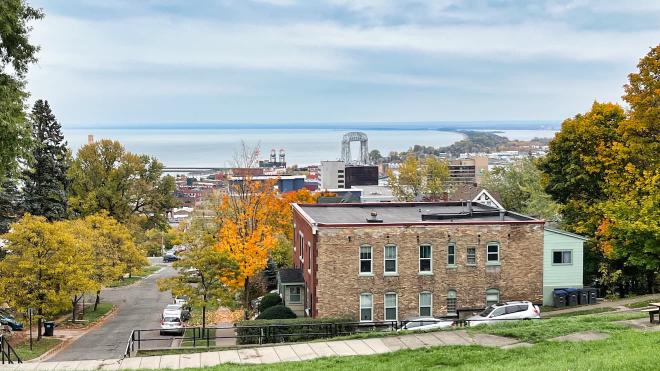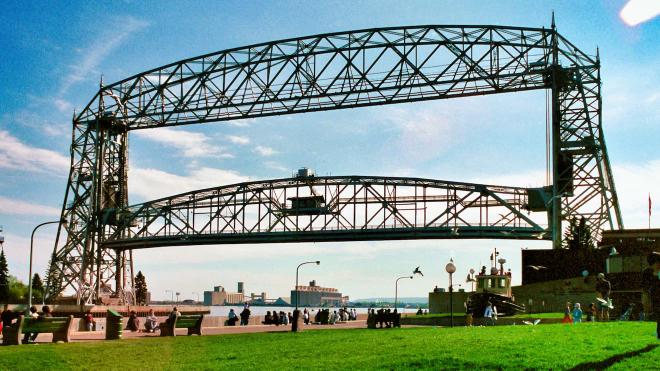Duluth, Minnesota

Duluth is officially the fifth-largest city in Minnesota. However, three of the top four are Minneapolis, St Paul, and Bloomington, and each of those is around 15km from the others, in a triangle around the MSP airport. So after the MSP “Metropolitan Statistical Area” (3.7 million people), it’s a really fast drop off to Rochester (121,603), then Duluth.
Still, it’s the smallest place I’ve lived in as an adult. Cambridge, England had a population of around 116,000 when I lived there; the Boston metro area was around 4 million when we lived there; and the Austin Texas metro area is now over 2 million people, having doubled in population during our time there.
I’d always thought of myself as a big city person, but the pandemic really changed that. Suddenly crowded places weren’t just something to put up with, they were an actual danger. In addition, Austin’s infrastructure has totally failed to keep up with the population growth, and the cool stores and restaurants we liked started to get priced out of business.
Being used to perpetually awful traffic and unreliable or nonexistent public transit, it’s very strange to now be in a city where you can decide to go somewhere, and 15 minutes later you’re actually there — even if the place in question is Wisconsin.
That’s another thing I find odd. I’ve never lived this close to a state border before. Now I can cross a bridge and suddenly the laws are different, the sales tax is different, and perhaps strangest of all the accents are different.
Duluth is situated in the south west corner of Lake Superior. It started out as a trading post in the 1600s, and takes its name from the French explorer Daniel Greysolon, Sieur du Lhut, sometimes anglicized as Sieur DuLuth.
The areas around Lake Superior belonged to the Ojibwe people, but in 1850 President Zachary Taylor (a southerner and slaveholder) ordered them to give up their land and move west of the Mississippi. This was a violation of treaties agreed to in 1837 and 1842, that had offered the Ojibwe annuities as compensation for the land they had ceded to settlers.
When the President’s order failed, agents of the government told the Ojibwe that to receive the annuities they were owed, they would need to travel 450km west by canoe to Sandy Lake to collect them in person. They would also need to make the journey in the fall, meaning they would not be able to harvest their crops — but they were told that there would be supplies for them at Sandy Lake.
Over 5,500 Ojibwe set out on the journey west. When they arrived they had no food, and winter was setting in. The government sent a token three day supply of food, and partial payment of the annuities owed. Hundreds died at Sandy Lake, and hundreds more died trekking home during the winter, a journey they had not expected to have to make. It became known as the Sandy Lake Tragedy, though to me “tragedy” seems an inappropriate term for something deliberately planned; it’s also known as the Chippewa Trail of Tears, or the Wisconsin Death March.
In the aftermath of Sandy Lake, many Ojibwe wanted to go to war with the Federal Government. Chief Kechewaishke — known as Chief Buffalo to the Europeans — persuaded them to try for peace one last time. In 1854 a treaty was signed by President Fillmore, setting up permanent lands for the Ojibwe in Wisconsin and Minnesota, and preserving their rights to the resources of the lands they agreed to share with the settlers. About a half hour drive west of Duluth is the Fond du Lac Reservation.
In 1857 Duluth was incorporated as a city. Just over ten years later it was one of the fastest growing cities in the US, and was predicted to surpass Chicago, as it was the only port with access to both the Atlantic and Pacific oceans. For a while in the 20th Century it was the busiest port in the US. Its economic decline started in the 1950s, though, when the Minnesota iron range became depleted of high grade ore. Still, the port remains the largest freshwater port, and is still busy — huge ships come and go, and people collect along the waterfront to watch them.
Since the decline of Minnesota’s iron industry, Duluth has shifted towards tourism. It’s a popular destination in summer, and also in winter for cross-country skiing, snowshoe hiking, snowmobiling, and so on. It’s also the main medical center for northern Minnesota, and home to a University of Minnesota campus.
The city is perhaps best known for its iconic aerial lift bridge, which raises to allow huge cargo ships to pass underneath. When it’s down, you can drive across at 20mph. When it’s up, you have to sit and wait for the ship to pass and the bridge to be lowered. Locals refer to this as being “bridged”.
